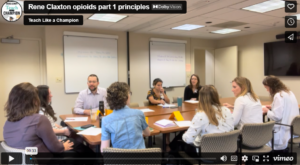09.06.23The Power of the ‘Roll Out Speech,’ Featuring Associate Professor of Medicine Rene Claxton

Training better doctors…with transparency about methods
Next week Erica Woolway, Sadie McCleary and I will be leading the first session in a remote workshop on teaching for medical educators. It’s our second time offering the workshop and we’ve found it really fun and fascinating to talk about how Wait Time and Everybody Writes and Cold Call can apply to–and accelerate learning during–the education doctors receive.
One of the best parts of the workshop is that we get to show video of both K-12 teachers and medical educators. And our newest clip–we just added it to the workshop this morning–is this one of Rene Claxton and her colleague Maria Lowry. It’s the first day of a course for Palliative and Supportive Institute clinicians at University of Pittsburgh Medical Center and Rene is giving what we call a “Roll Out Speech”… it’s a very brief explanation for students of the how and why of a specific teaching technique the teacher will be using.
In this case, Rene is explaining and making explicit her use of Cold Call and Habits of Discussion. She uses these techniques because…. well, I’ll let her explain them herself:
It’s such a service to students to know what to expect from the teacher and why. And it’s such an exemplar of team teaching that Rene explains the what and why and Maria then uses those techniques right away! Great teamwork!
Some things we loved:
- Rene’s explanation of the “why” for Cold Call–which focuses on two reasons for her use of the technique. 1) “We want to hear your voice. It helps us gauge how good of a job we’re doing teaching”–we love that she explains that its partly about she and Maria understanding the effectiveness of their own teaching. Most students probably hadn’t thought of that. And if I hear on the first day that my teacher is always assessing how well she has taught me, I am much more bought in to the process as a student. 2) “And,” she notes, “It helps all pay attention.” Before summarizing one of the key findings of cognitive psychology, “What you pay attention to is what you learn.” The other big reason for their use of the technique is to help students learn more. This sort of framing will help them see it as a positive part ofthe learning process.
- The “Culture of Error” framing. “It is ok if you don’t know the answer,” Rene says. “That’s why you’re learning. Because you don’t,” beautifully diffusing potential anxiety about not getting it right- it’s a safe bet that doctors feel this strongly. And glory points for the what to do about it: “So just say pass and we’ll come back to you.”
- Getting started right away. The roll out speech only works if Rene and Maria let students experience what they’re talking about right away. So after Rene has explained Cold Call and Habits of Discussion Maria Cold Calls and asks for a participant to build off that answer. Bonus points for choosing on the first iteration a student whose notes are visible and therefore is likely to be successful the first time through!
There are lots more great details here but I’ll just close by pointing out how fast it is. Less than two minutes and everyone understands what to expect and why it will make them successful. And before they know it they’ve tried it out.
FYI if you’re a medical educator and find this interesting, we still have a few spaces left in our upcoming workshop. It’s running Tuesday and Thursday afternoons throughout September. Details and registration here:
https://teachlikeachampion.org/medical_educator/sept2023
And thanks to Rene and Maria for sharing their amazing work!
